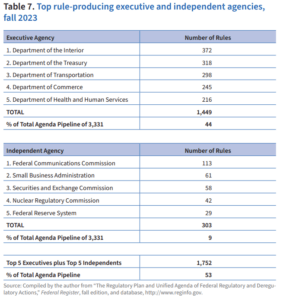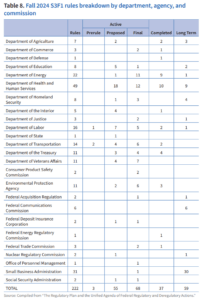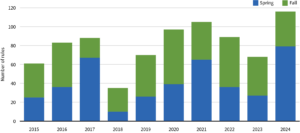Chapter 7:Unified Agenda of regulatory actions
Along with the Report to Congress, Federal Register, and Code of Federal Regulations, another vehicle for regulatory disclosure is the spring and fall editions of the “Regulatory Plan and Unified Agenda of Federal Regulatory and Deregulatory Actions.” Agencies outline regulatory goals and intentions in the Unified Agenda, particularly in the fall Regulatory Plan component.
The Unified Agenda is not a complete compendium of all rules like the Federal Register. Instead, it presents a cross–section of regulatory priorities from over 60 federal departments, agencies, and commissions along three categories:
- Active actions: prerule measures and proposed and final rules in the production process
- Completed actions: rules finalized (or withdrawn) during the previous (roughly) six months since the prior Unified Agenda
- Long-term actions: rulemakings anticipated to take place beyond a 12-month horizon
The Unified Agenda reflects administrations’ different priorities in different years, such as a rulemaking pause during the 2012 election season. Agencies are not required to limit their regulatory activity to the material published in the Unified Agenda unless an administration instructs otherwise. Rather, the Unified Agenda “reflect[s] what the agency wants to make public, not necessarily all activity under consideration, and some highly controversial issues may be withheld.” The Biden administration’s pursuit of regulatory net benefits contrasts with the “one-in, two-out” streamlining mindset reflected in the semiannual Unified Agendas between 2017 and 2020, when hundreds of entries were deemed deregulatory.
Most rules in the Unified Agenda are not new but are carryovers from prior editions as they advance through stages, sometimes slowly. In the fall 2024 edition, 275 active rulemaking actions appeared for the first time, compared with 320 the previous fall (and over 400 in both Biden’s first year and Trump’s last).
The fall 2024 “Regulatory Plan and Unified Agenda of Regulatory and Deregulatory Actions” found 69 departments, agencies, and commissions listing 3,331 rules in the active (prerule, proposed, and final), recently completed, and long-term stages (Figure 18). Most of the active rules have been in the pipeline for some time. This compares to 3,599 in fall 2023. Table 6 breaks out by department, agency, and commission the 3,599 rules in the active, completed, and long-term stages.

Biden continued a longstanding tradition of reporting well over 2,000 rules in the active phase. The only recent exception was a dip in 2017 under Trump to 1,977 rules, that also contained among them 448 rules deemed deregulatory. Notably, as the top bar of Figure 18 hints, Biden’s long-term rule planning resumed Obama-era levels. Historically, through 2013, the Unified Agenda often exceeded 4,000 active, completed, and long-term rules. Unified Agenda counts were highest in the 1990s, peaking at 5,119 rules in fall 1994 before a series of mid-1990s regulatory reforms. The fall 2017 Unified Agenda pipeline of 3,209 contained the fewest rules since 1983, even without counting that Trump edition’s 540 deregulatory entries. (For a history of the total numbers of rules in the Unified Agenda from 1983 to the present, see Appendix I.)



A relative handful of executive branch agencies each year account for the greatest number of rules in the pipeline. In the fall 2024 Unified Agenda, the Departments of the Treasury, the Interior, Transportation, Commerce, and Health and Human Services are the most active (see Table 7). These top five, with 1,449 rules among them, account for 44 percent of the 3,331 rules in the pipeline. The Environmental Protection Agency, with 190 rules, takes sixth place. The FCC, with 113 rules, leads the pack among the independent agencies.
The top five independent agencies in the Unified Agenda pipeline by rule count (excluding the multiagency Federal Acquisition Regulations System’s 61 and the Office of Personnel Management and the General Services Administration) are the FCC, Small Business Administration, Nuclear Regulatory Commission, Securities and Exchange Commission, and the Federal Reserve System. Their total of 303 rules accounts for 9 percent of the 3,331 rules in the fall Unified Agenda. Combined, the top five executive and independent agencies, numbering 1,752, make up 53 percent of the total.

Biden’s new $200 million rules
From 1993 until April 2023, rules with economic effects of at least $100 million in a year were classified as economically significant. Biden’s EO 14094 raised the cost threshold for a significant regulatory action to $200 million and changed its name to a Section 3(f)(1) Significant designation (or S3F1). Until Trump’s revocation of Biden’s EO 14094, OMB referred to economically significant in the past tense:
This term [economically significant] was used for regulatory actions reviewed between September 30, 1993, when EO 12866 was issued, and April 6, 2023, when the Modernizing EO was issued. The term referred to a regulatory action as determined under Section 3(f)(1) of EO 12866, that will have an annual effect on the economy of $100 million or more or will adversely affect in a material way the economy, a sector of the economy, productivity, competition, jobs, the environment, public health or safety, or State, local, or tribal governments or communities.
As Figure 19 shows, 222 rules in the pipeline are designated as having $200 million in annual economic impact (compared to 304 in fall 2023). That implies eventual combined annual effects of more than $44 billion, which is notable in the context of the $77 billion in annualized regulatory costs being added over the past four fiscal years (Table 3). Of these, 126 are active, 37 recently completed, and 59 long-term (a surge from 3 in fall 2023). Table 8 presents an inventory of these 222 rules by the 25 issuing departments and agencies. Of the completed, 9 were from the Department of Energy, 10 from HHS.

Agenda
Figure 19’s depiction of fall 2024’s 222 S3F1 rules includes those designated economically significant through fall 2022. Although a marked drop might be expected given the higher $200 million rather than $100 million threshold, the new count nonetheless matches earlier years depicted, despite a large drop in the “active” component over the past year. Appendix J contains the full list of S3F1 rules—233 active and 30 long-term—that agencies affirm to be in production as of fall 2024.

Recognizing that overlap occurs in transition years after elections (for example, Biden issued 68 significant, under EO 12866, rules in the interval between the fall Unified Agenda and Trump’s inauguration), here are calendar-year breakdowns of yearly average high–significance active rules in play under recent administrations in their fall Unified Agendas. Note that Biden showed considerably more activity despite the higher threshold he himself established in 2023:
- George W. Bush (eight years): average 87 in fall Unified Agendas.
- Barack Obama (eight years): average 133 per year.
- Donald Trump (four years): average 120 per year.
- Joe Biden (four years): average 202 per year.
Figure 19 represents flows of the fall Unified Agendas. While this creates a thorough year-end snapshot as far as active and long-term rules are concerned, incorporating the spring Unified Agendas is necessary for the full picture of the completed subset during any given year. Figure 20 captures the 79 completed economically significant rules in the spring of 2024, plus fall 2024’s 37 completed S3F1 rules. Despite the higher $200 million threshold compared to the $100 million one of earlier years, high-significance completed rules surged to a total of 116 in 2024 in the Biden administration. There were 285 additional Biden rules between the December 13 Unified Agenda publication date and the Trump inauguration.

Agenda
Again recognizing transition year overlap, here are calendar-year breakdowns of completed highly significant rules under recent administrations. Biden’s average is highest at 95 completed per year, even with the shift to the higher $200 million threshold.
- George W. Bush (eight years): average 49 completed economically significant rules per year.
- Barack Obama (eight years): average 69 completed economically significant rules per year.
- Donald Trump (four years): average 73 economically significant rules per year (includes over 50 deregulatory during the term).
- Joe Biden (four years): average 95 highly significant rules per year.
Despite Biden’s EO 14094, major rules retain the $100 million threshold specified in the Congressional Review Act. Box 1 inventories the combined spring and fall S3F1 completed actions for 2024, plus that wider set of major rules to be discussed shortly. An S3F1 rule is automatically major, bringing the total number of 2024’s recognized high-dollar rules to 146.
The emphasis on the high-cost rule subsets should not distract policymakers and analysts from the remaining bulk of rules in the annual pipeline. Many of these can and do have substantial costs or effects in their own right.







